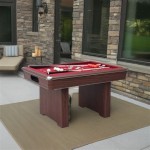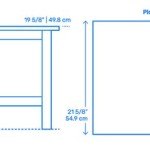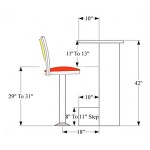Height of Study Table: A Comprehensive Guide in Millimeters and Inches
The height of a study table is a critical factor influencing comfort, posture, and overall productivity during study sessions. An improperly sized table can lead to discomfort, musculoskeletal strain, and decreased focus. Therefore, understanding the optimal height range for a study table, expressed in both millimeters (mm) and inches, is essential for creating an ergonomically sound workspace.
This article provides a comprehensive guide to determining the ideal height of a study table, considering factors such as individual height, chair height, and the specific type of work being performed. It will explore the general recommendations, the impact of table height on posture, and strategies for adapting existing tables to achieve a more comfortable and efficient study environment.
Understanding Standard Study Table Heights
While individual needs vary, there are standard height recommendations available for study tables. These standards are generally based on average adult heights and are designed to accommodate a broad range of users. These standard heights provide a starting point for determining the most appropriate height for a particular individual.
The most commonly cited standard height for a desk or study table is 750 mm (approximately 29.5 inches). This height is generally considered suitable for individuals of average height, typically ranging from 5 feet 8 inches (173 cm) to 6 feet (183 cm). However, it is crucial to recognize that this is simply a guideline, and adjustments may be necessary to accommodate individual variations and specific needs.
For children and younger students, the standard height is significantly lower. Tables designed for children typically range from 460 mm (18 inches) for preschool-aged children to 710 mm (28 inches) for older elementary school students. The appropriate height depends directly on the child's overall height and should be chosen to allow them to sit comfortably with their feet flat on the floor and their elbows at a 90-degree angle.
It is important to note that these standard heights are often based on assumptions about chair height. Ideally, the chair should be adjusted so that the user's feet are flat on the floor, their knees are at a 90-degree angle, and their elbows are also at a 90-degree angle when working at the table. If the chair is not adjustable, or if the user prefers a higher or lower seating position, the table height may need to be adjusted accordingly.
The Impact of Table Height on Posture and Comfort
The height of a study table directly affects posture and comfort. An incorrectly sized table can lead to a variety of musculoskeletal problems, including neck pain, back pain, and carpal tunnel syndrome. Therefore, careful consideration should be given to choosing a table height that promotes proper posture and minimizes strain.
A table that is too high can cause users to hunch their shoulders and raise their arms, leading to fatigue and pain in the neck and shoulders. It can also restrict blood flow to the hands and wrists, increasing the risk of carpal tunnel syndrome. If the table is too high, the user may also have difficulty reaching the keyboard and mouse comfortably, further exacerbating these problems.
Conversely, a table that is too low can cause users to slouch forward, putting strain on the lower back. This can lead to chronic back pain and other spinal problems. It can also lead to neck pain, as users may need to crane their necks to see the screen. Furthermore, a low table can compress the diaphragm, restricting breathing and leading to fatigue.
The ideal table height allows the user to sit comfortably with their feet flat on the floor, their knees at a 90-degree angle, and their elbows at a 90-degree angle. The forearms should be parallel to the floor, and the wrists should be straight. The monitor should be positioned at eye level, so the user does not have to crane their neck to see the screen. Maintaining this correct posture minimizes strain and promotes comfort during long study sessions.
The depth of the study table is also an important ergonomic consideration. A sufficient depth allows for ample space to position the monitor at a comfortable viewing distance, which further reduces eye strain and neck fatigue. A shallow desk forces the user to sit too close to the screen, increasing the likelihood of discomfort.
The importance of good posture cannot be overstated. It not only impacts physical well-being but also cognitive function. Proper alignment allows for optimal blood flow and nerve function. Compromised posture can restrict these processes, subsequently impacting focus and concentration during study.
Adapting Existing Tables and Choosing Adjustable Height Tables
In some cases, it may not be feasible to purchase a new study table. However, there are several strategies for adapting existing tables to achieve a more comfortable and ergonomic workspace.
One common solution is to use a chair with adjustable height. By adjusting the chair height, it is possible to compensate for a table that is slightly too high or too low. However, it is important to ensure that the chair provides adequate support and that the user's feet can still reach the floor comfortably. If the chair is raised too high, a footrest may be necessary to provide adequate support.
Another option is to use a keyboard tray. A keyboard tray can lower the keyboard and mouse, allowing the user to maintain a more comfortable wrist position. This is particularly useful for tables that are slightly too high. Keyboard trays often come with adjustable height and tilt features, further enhancing their ergonomic benefits.
For tables that are too low, risers can be used to raise the height. These risers are typically placed under the legs of the table and can be purchased in a variety of heights. It is important to ensure that the risers are sturdy and stable to prevent the table from wobbling.
Adjustable height tables, also known as standing desks, are becoming increasingly popular. These tables allow the user to easily adjust the height of the table, allowing them to alternate between sitting and standing throughout the day. This can help to reduce fatigue and improve posture. Adjustable height tables are available in a variety of styles and price ranges, making them a viable option for many users.
When choosing an adjustable height table, it is important to consider the range of height adjustment. The table should be able to adjust to a height that is comfortable for both sitting and standing. It is also important to consider the weight capacity of the table and the stability of the table at different heights.
Regardless of whether the table is fixed or adjustable, adequate cable management is essential. Excess cables can clutter the workspace and create a tripping hazard. Cable management systems, such as cable trays and cable ties, can help to keep cables organized and out of the way, further contributing to a safer and more efficient study environment.
Finally, consider the placement of the study table within the room. Natural light is ideal for studying, so positioning the table near a window can be beneficial. However, avoid placing the table directly in front of a window, as the glare can be distracting. Adequate artificial lighting is also essential, especially for studying at night or on cloudy days. A combination of ambient lighting and task lighting is recommended.
Choosing the correct height for a study table is crucial for maintaining a comfortable and productive study environment. By understanding the standard height recommendations, considering individual needs, and adapting existing tables when necessary, individuals can create a workspace that promotes proper posture, minimizes strain, and enhances overall well-being.

Desk Height Calculator

Standard Polished White Stainless Steel Study Table At 4400 Piece In Bengaluru

White Multi Purpose Sitting Study Desk Size 24x16x9 5 Inch At 500 Piece In Kekri

Brown Wooden Royal Finish Minimal Study Table Size 42 L X30 H X23 D 1 At 6195 Piece In Churu

61sgohhd0vs Sl1500 700x Crop Center Jpg V 1680512457

71eiok1kbal Sl1500 700x Crop Center Jpg V 1680510759

Wooden Rectangular Kids Study Table With Chair Storage Drawer At 8500 Set In New Delhi

Panck Study Table Urban Ladder

Home Office Smart Ergonomic Desk Furniture Height Width Adjustable Round Column Dual Motor Standing Up 3 Stage Computer Table Made In China Com

Choosing Perfect Conference Tables Dimensions A Simple Guide Wanbest
Related Posts








